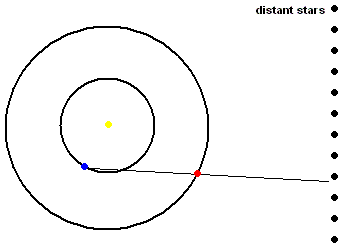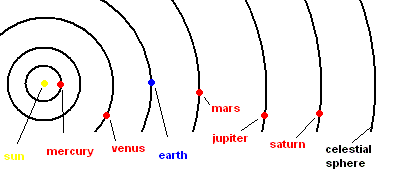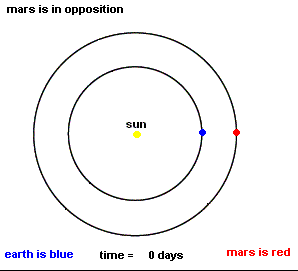
from http://www-istp.gsfc.nasa.gov/stargaze/Ssolsys.htm

from
http://www-istp.gsfc.nasa.gov/stargaze/Ssolsys.htm
Nicolaus Copernicus (1473-1543) was born in Poland. His polish name was Mikolaj Kopernik, but we will use the more familiar Latin version - Copernicus. His contemporaries included Columbus, Martin Luther, Leonardo da Vinci, and Michelangelo - all great men of the Renaissance. His father died when he was 10, and he was raised by a wealthy uncle who also was a bishop in the church. The uncle was able to send Copernicus to many of the best universities in Europe where Copernicus was trained in many fields including church law (canon law), medicine, and law. Church law required students to take astronomy (as well as medicine ... for purposes of making astrological horoscopes of his patients). In these classes, Copernicus learned the Ptolemaic system in all its detail. Copernicus was not a professional astronomer! Astronomy was more a hobby for him after his long education. He was appointed a canon (something like a mayor) in Frauenburg for over 30 years. So what drove this man to ignite a scientific revolution, and how did it happen?
Ptolemy constructed one of the most elaborate models ever conceived to describe the motions of all celestial objects. Although complex, it did what it was designed to do, explain and predict the observed motions of the moon, sun, and planets. That is a necessary component of any scientific model. If you asked a Greek where Mars was going to be in 2 years, all you had to do was spin the spheres in advance, and give an answer ... and it worked, but tiny errors in the system mounted as the centuries moved on. Eventually the model no longer predicted what was observed, and the system had to be "reset" on occasion (much like a watch needs periodic resets every few months). This is an embarrassing glitch in a system which was suppose to be perfect (and certainly not expected by Ptolemy himself).
Have you ever heard of the KISS theory? KISS stands for Keep It Simple, Stupid! There is a general belief in science that nature can be understood and when it is, it should be simple and esthetically pleasing. The Ptolemaic model was failing on this last count ... it was not simple to begin with ... and now it had to be "fudged" on occasion to make it work. I believe even the church was ready for reform, but Ptolemy was so tied up in doctrine that reform would be difficult at best. So along comes Copernicus ...
We know Copernicus spent a great deal of his spare time struggling with the Ptolemaic system. Around 1514 he hand wrote an essay, Little Commentary, which was unsigned, but distributed to his closest friends. In it, he questions the validity of the Ptolemaic model. Only a few copies still exist .. if you find one, you can retire now. It is likely he was laying the foundation for his great book, De revolutionibus (which was probably completed much earlier, but published in 1543).
In his book, Copernicus gives logical reasons why the sun should be at the centre of the universe:
At the middle of all things lies the sun. As the location of this luminary in the cosmos, that most beautiful temple, would there be any other place or any better place than the centre, from which it can light up everything at the same time? Hence the sun is not inappropriately called by some the lamp of the universe, by others its mind, and by others its ruler.
He also points out inconsistencies in the Ptolemaic model to establish his own agenda. One deals with the brightness of Mars in the old system. He argues that Mars will appear brighter at times because Ptolemy's epicycles bring it physically closer to the earth at times, but not enough to account for its observed brightness. He also points out that the celestial sphere must be at such a great distance from the earth as to produce no observable parallax.
If you recall, all planets occasionally move backwards (westward against the stars) in a manor known as retrograde motion. The file is large .wmv format (2 MB) OR .mp4 format (2 MB).

Probably the most convincing argument Copernicus could offer to support his model was explaining the retrograde motion of the planets. Study the animation to the left which shows the natural consequence of a moving earth (shown in blue) as it tracks the location of a moving planet (shown as red) against the celestial sphere. He claimed that this bizarre motion is quite natural in the heliocentric universe. In the Ptolemaic model, you needed to invent all kinds of tricks to produce the same motions in the sky ... in the heliocentric model, retrograde motion is inevitable as the faster moving earth moves around and eventually passes the slower moving outer planets. Copernicus noted that the size and durations of the retrograde loop for each planet is consistent, natural and inevitable in a sun centered universe.
Retrograde Motion (animation)
These arguments are not proofs. In fact, Copernicus offers no proof at all to establish his own model (later we will see that science doesn't work that way). He relies on the simplicity of a heliocentric (sun centered) universe to explain the observed motions of the heavens. The KISS theory! Note: The model Copernicus offers is not without complications. For example, by assuming only circular motion for all celestial objects, he is forced to move the sun slightly "off center" and even maintained the use of epicycles to "fine tune" his model with observations.
Getting a book to publish these controversial ideas is no easy matter. At the risk of condemnation, he avoided publication and only confided his ideas to a small circle of friends. By 1543, Copernicus was old and dying. At the urging of his colleagues, he agreed to publish, and entrusted the task to a friend, Andreas Osiander. Fearing that the book was too controversial to pass the censure, Osiander added a preface to the book which basically amounted to a disclaimer. This hand written text stated that the material presented in the book should not be taken literally, but rather for purposes of mathematical simplification only. The book passed the censure and was published. The only problem was, book readers back then did exactly what they do now ... skip the preface and go directly to chapter 1. Once the church realized that some people were taking this book seriously, it was too late. Copernicus only planted the seeds of doubt. Ptolemy was still firmly in control for the next 70+ years. We save this story for the next unit. For now, I will ask you to accept the heliocentric model, so we can establish some vocabulary.

The Heliocentric Model - (not to scale)
By placing the sun at the center of the universe, a whole new list of astronomical terms arise. The planets Mercury and Venus are considered inferior planets. The planets Mars, Jupiter, Saturn (and later Uranus, Neptune and Pluto) constitute the superior planets. These names come from our viewing opportunity. Generally speaking, the best time to see an astronomical object is when it is physically closest to us. This is not the case with the inferior planets.
|
Don't look for Venus here! |
This is when we have the "best" view of Venus. |
The image to the left shows that Venus can get very close to the earth, but don't look for Venus then. First, you would have to stare directly into the sun to catch a glimpse of Venus, and even then you would not see anything because the side illuminated by the sun is facing away from us. The only exception is if you were able to see Venus as it moves across the disk of the sun ... but this is an extremely rare event (which last happened in 2012). The image on the right shows that our best view of Venus occurs when it makes its biggest angle from the sun (which is generally 46-47 degrees). Since Venus never gets far from the sun, our best hope is to catch it hovering over the eastern horizon just before sunrise (morning star) or just after sunset hovering over the western horizon (evening star). The angle a planet makes with the sun is known as the elongation. The maximum elongation for Venus is 46-47 degrees. Mercury's maximum elongation is only 28 degrees making it even harder to spot in the sky. You can see how these two planets are collectively known as the inferior planets.
I made a movie that will, hopefully, help you understand how the inferior planets move. The file is very large .wmv format (12 MB) OR .mp4 format (8 MB).
Any planet with an orbital radius bigger than the earth will give much better viewing opportunities at times. Consider the image below which shows the planet Mars when it is closest to the earth.
You can see that the side of Mars which is illuminated by the sun is facing the earth. This gives the very best viewing opportunity of Mars ... giving you an idea why it is considered a superior planet. Sometime interesting alignments occur between the earth, sun, and planet. The generic word for "alignment" is configuration, and we need to discuss two configurations in particular. The image to the left is called an opposition of Mars because Mars appears directly opposite the sun (as seen from earth). Any superior planet is seen best when it is in opposition. At that time it will appear brighter than any other time, and you would expect to see it on the meridian around midnight. It should be obvious that Mercury and Venus will never experience an opposition.
So
when is the worst time to view Mars? It is when it is hidden in the glare
of the sun! This configuration is known as a conjunction of Mars
and is illustrated on the picture to the right. You should see that all
planets (including inferior planets) can experience a conjunction. I've
included the orbit of Venus and labeled the two points (A and B) where you have
conjunctions of Venus. Point "A" is called the superior conjunction and
point "B" is considered the inferior conjunction. Either case, these would
be bad times to view Venus. The term conjunction literally means "to line
up with". If you read that Jupiter is in conjunction, it is assumed to
line up with the sun. On occasion, two planets may line up in the same
section of the sky in which case the headlines might read, "Venus is in
conjunction with Mars this week".
Copernicus was able to make a "scale model" of the known solar system. He did not have legend to his map since the exact distance to the sun was not known with accuracy. The earth-sun distance was simply given a unit value and called an astronomical unit (AU). To Copernicus, the earth-sun distance did not change (we will see later that it does). Using this convention, he was able to place all the planets orbits to proper scale and assigned distance of all planets to the sun in AU. His numbers matched up incredibly well with the modern values.
|
Scale of the Solar System in Astronomical Units |
||
| Planet | Values of Copernicus | Modern Values |
| Mercury | .38 | .39 |
| Venus | .72 | .72 |
| Earth | 1.00 | 1.00 |
| Mars | 1.52 | 1.52 |
| Jupiter | 5.2 | 5.2 |
| Saturn | 9.2 | 9.6 |
Scale Model of Copernican Universe
The time it takes a planet to orbit once around the sun is known as the sidereal period. The sidereal period of the earth is 365¼ days or 1 year. The inferior planets take less time to complete a revolution around the sun. Mercury takes only 88 days to orbit the sun whereas Pluto (not known to Copernicus) takes 248 years to make one revolution (birthdays are rare on Pluto).
You already know that a superior planet is best seen at opposition. During that time, the earth will be physically closest to the planet and it will appear brighter than at any other time. Amateur astronomers will take out telescopes when Mars, Jupiter, or Saturn reach opposition. Once that event passes, it is destined to return. One needs only to look up the synodic period of that planet to discover the next time this event will reoccur. This number will tell you when any planet returns to the same configuration, regardless what alignment you are considering. For example, the synodic period for Mars is 780 days (see the animation below). Therefore, Mars comes into opposition every 780 days.

The synodic period of Mars (animation)
I have a better animation. The file is large .wmv format (5 MB) OR .mp4 format (4 MB).
Thought questions:
In early April, 2014, Mars reached opposition. If the synodic period of Mars is 780 days, when will the next opposition occur?
Venus was extremely prominent (at its greatest elongation) in the western sky just after sunset in late October 2013. If the synodic period of Venus is 584 days, when can you expect the same event?
Why do planets that are farther from the sun have synodic periods which get closer and closer to 365¼ days?
©Jim Mihal 2004, 2014- all rights reserved